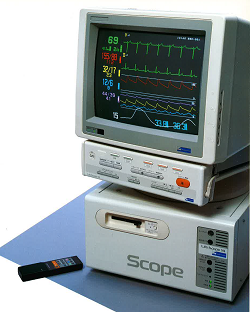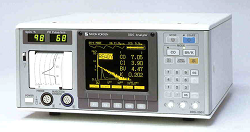
- 拡大
- Life Scope 14 bedside monitor
In 1991 the company celebrated its 40th anniversary. Since its founding, the number of Nihon Kohden Group employees had increased 100 fold to 2,500 employees. Sales had increased 4400 fold to 54 billion yen, capital had increased 5900 fold to 4.7 billion yen. Nihon Kohden had risen to become a top manufacturer of medical electronic equipment.
New product development continued. In 1992 the high-end Life Scope 14 BSM-8800 bedside monitor was developed to fulfill the high level requirements of the increasingly advanced level of medical care.
In 1995 we received ISO 9001 certification - the international standard of quality assurance.
Nihon Kohden expanded in Asia. In 1991 Shanghai Kohden Medical Electronic Instrument Corporation was established to manufacture and market single channel electrocardiographs for China. In 1996 Nihon Kohden Singapore was established to serve Southeast Asia countries.
In 1997 Nihon Kohden participated with 3 Japanese and American medical facilities in the world's first experiment in remote medicine. This experiment yielded valuable information and experience which will help in the future development of this important medical field.

Digital ECG telemetry first appeared in this 8-patient telemetry monitor. Lightweight transmitters attached to the patient allowed the patient freedom of movement. This was ideal for rehabilitation and cardiac monitoring.

Digital multi-parameter telemetry first appeared in these monitors and has become an essential part of modern monitors. Multi-parameter telemetry greatly expanded the applications of wireless monitoring networks.

This was Japan's first 32 channel digital EEG. This breakthrough allowed such features as recording of more channels on the paper, recording of alphanumeric and graphic data in addition to waveforms, and lower noise and higher electrical safety to allow NICU and OR application. This EEG also had a 7" CRT screen to monitor the patient image.

This was the world's first telemetry stimulator.

This Windows® 3.1 PC based EEG provided unparalleled ease of use. All functions could be quickly accessed with a mouse. The successor model, EEG-2110, was the world's first Windows 95 based EEG.

This PC based, high-end system runs on Windows NT® for excellent stability and networking capability. It was the first evoked potential/EMG system in the world to offer multi-tasking. Multi-tasking allows the physician to have different examinations and screens open at the same time, and switch between them with a simple mouse click.

As featured in the December '98 issue of Anesthesiology, this unique instrument tests hemodynamic function easily and less invasively at the bedside. With a clip-on finger probe and injection of dye into a vein, the DDG-2001 measures cardiac output and index, circulating blood volume and plasma ICG disappearance rate. Unlike other blood volume measurement methods, this new method does not require radioisotopes, Swan-Ganz catheter or cutdown (incision of vein). DDG-2001 uses the principle of pulse dye densitometry which is similar to the principle of pulse oximetry. Both of these were invented by Nihon Kohden researcher Takuo Aoyagi.

This EEG has 192 channel simultaneous sampling with 64 channel display. The large number of channels is essential for epilepsy monitoring and epilepsy surgery. A variety of electrode junction boxes and high performance PC with Windows® 98 assure flexible performance as well as easy networking, databasing and report generation.
Windows is a registered trademark of Microsoft Corporation.
